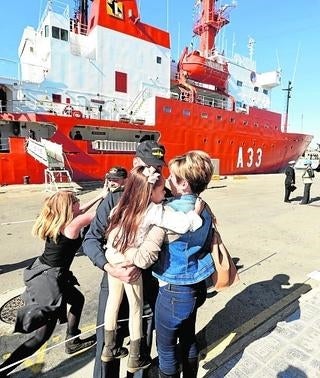
Professor Cristina de Ignacio from the University Complutense (UCM) describin the cores. We plan to proceed with seismic operations during the night shifts. This is a fastidious process that requires the involvement of the whole team. Alongside with the ship’s operations the scientific team has been treating and subsampling the water and sediment core samples. At around 6 pm we have approached the “Juan Carlos I” Spanish base to proceed with logistic operations. Along day we have made a couple more CTD profiles and 3 gravity corers in an area influenced by an active N-S fault that controls, to the south, the Eastern limit of Deception island. Even so and following a careful approach we have done a CTD right the core of the pot mark (roughly 80 m deep) and quickly exit the area to deeper waters. The location of these submarine features posed a navigation difficulty as they are relatively shallow, and the navigation charts showed rock pinnacles emerging almost vertically in the surrounding areas. Soon after it was decided navigate towards the southern coast of Livingston island to probe curious pot marks visible in the high resolution bathymetry. Ana Lobato working on the GIS to plan the lines and sampling sites.Ĭontinuing from last night, the day started with sparker seismic data acquisition. Our plans for the next day is to proceed with the high resolution bathymetry to finally cover the entire section of Axe volcano. We have now important data that we can use to better understand the system that lays below us. Total we did 6 CTD profiles and 4 gravity corers. We then continued with gravity corers supported by TOPAS information and managed to retrieve ash and coarse volcaniclastic material from the volcano. The first couple of targets, on top of linear volcanic vent cones inside the main crater, gave seawater column anomalies.
#Hesperides antartida series#
Based on this information we set up a series of target points, inside the volcano, to further investigate for hydrothermalism by using CTD profiles and gravity corers. We have crossed the system early morning using seismic data acquisition, TOPAS (sub-bottom profiler) and high-resolution bathymetry.


This volcano lays right in the centre of a linear ridge system and is a potential host for hydrothermal activity. Today the Hespérides was set to explore the Axe Volcano, located just East of Deception Island. Tomorrow we will follow up with the exploration of shallow hydrothermal exploration During the night we will proceed with seismic and CTD profiles (this time from the ship). We have recovered a large amount of samples that are now being processed and stored for further analysis. Fluid geochemists sampled gas from the strongly steaming fumarole 1. Javier Gonzalez (on the lower right) from IGME sampled sediments, precipitates and rock samples with material associated to the fumarolic activity. On-land, fluid geochemists (Maria Asensio and Cecilia Amonte, on the lower left) from the INVOLCAN sampled gas from the strongly steaming fumarole 1. From the Zodiac the EMEPC team followed a sampling grid and proceeded with exhaustive CTD profile analysis and water sampling of the submarine fumaroles. The first group headed to the Island in early morning during low tide to sample inter-tidal fumaroles. The team was divided in several groups to fill in 3 work shifts on the island. Geodesy, Cartography and Cadastre Agency, 2016.Full work day at Fumarolas bay, Deception Island.


Livingston Island: Central-Eastern Region. Madrid: Servicio Geográfico del Ejército, 1991. The feature is named after the Spanish ocean exploration ship BIO Hesperides. The area was visited by 19th century sealers operating from nearby Johnsons Dock. Hespérides Point ( Spanish: Punta Hespérides) is a rocky point of land projecting into South Bay north-northwest of Johnsons Dock, Livingston Island in the South Shetland Islands, Antarctica and forming the southwest side of the entrance to Emona Anchorage. Topographic map of Livingston Island and Smith Island.


 0 kommentar(er)
0 kommentar(er)
